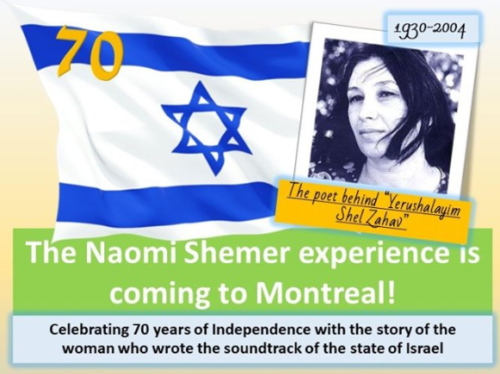
By Jacques Chitayat
On the evening of June 11th, over a hundred guests were gathered in Montreal’s Spanish and Portuguese Synagogue for an event hosted by the CIJR. Its Chairman, Jack Kincler, began the program by welcoming the event’s distinguished guests, such as former Justice Minister and Attorney General Irwin Cotler, Israel’s Consul General for Eastern Canada, David Levy, as well as yours truly, a student intern.
The Chairman then let Roy Rimshon, an Israeli teacher and the evening’s speaker, take the stage. Over the course of an hour and a half, the guests were delighted with a touching and well-constructed presentation of Naomi Shemer’s life. A prolific songwriter – born to pioneers who immigrated to the land from Lithuania, she grew up in Kibbutz Kinneret in the Jordan Valley in the 1930s and 1940s, and later resided in Tel Aviv – she wrote and composed over 1000 songs about the Jewish people and Israel that instantly became an integral part of Israeli culture. What made these songs so special was her remarkable talent for biblical-influenced poetry in Hebrew, especially in a time when the language was only starting to be commonly used again; her talent for perfectly combining words and melody; as well as her versatility of styles: she could just as easily write songs for children, about politics or about Judaism. Having lived in that region most of her life, including the almost 20 years before the State of Israel was established, her connection to the land was particularly strong.
Rimshon, himself a former resident of Kibbutz Kinneret, fused this presentation with detailed descriptions of life on the Israeli kibbutzim, Independence Day, the highs and lows of the Six-Day and Yom Kippur Wars, and of other significant periods of Israel’s history that Shemer’s life and songs came to embody and symbolize. Rimshon gave this presentation with great passion conveying tangible emotion when telling stories about the hardships of Shemer’s personal life whom he called “his personal hero”: the fascinating stories and situations in which she wrote her iconic songs and about the iron will of Jews who fought against all odds to defend their kibbutz from seemingly unstoppable Arab armies. For example, she was tasked in October 1973 with writing a song to support Israeli soldiers fighting in the Yom Kippur War and their families during its first days when young soldiers were dying by the hundreds, unknown to most Israelis. Shemer originally wanted to translate the Beatles’ Let it Be to Hebrew, but after her husband convinced her to not use a “goy’s song”, she rewrote the song’s melody and lyrics in the span of ten minutes, and immediately performed the newly-arranged and newly-written song, Lu Yehi, on live radio for the entire country, an example of her brilliant musical and poetic talent.
Rimshon enhanced his presentation by rare pictures and recordings of Naomi Shemer’s life, like a photo of her performing a song atop a boulder in her kibbutz when she was only 3 years old, as well as historic footage, such as Israeli soldiers breaking into tears when reaching the Western Wall at the conclusion of the Six Day War. Of course, an evening about this icon of Jewish music would not be complete without listening to her beautiful songs, which Rimshon enthusiastically interspersed during his presentation. The crowd hummed and sang to Shemer’s classics, most notably to Yerushalayim Shel Zahav, which she had composed only three weeks before Jewish soldiers retook Jerusalem in 1967, when the reunification of Jerusalem was only a far-off dream. Unbeknownst to many in the audience, the final stanza of that song was added by Shemer, Rimshon explained, minutes after learning about the retaking of the Old city, revealing, once again, her extraordinary creativity.
Rimshon concluded his presentation with a final video, Naomi Shemer’s B’Rosh HaShanah song, to which members of the audience spontaneously started dancing the hora in the head of the hall. It was such a joyous conclusion to Roy Rimshon’s emotionally gripping presentation of Naomi Shemer, arguably the Jewish people’s most talented songwriter.

